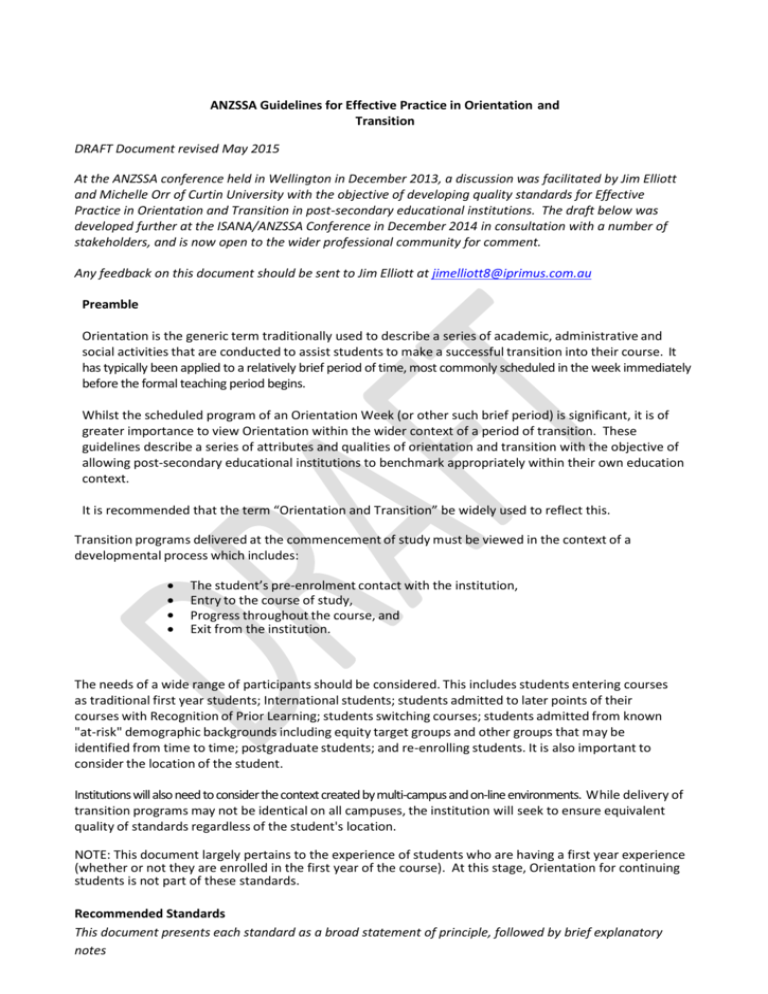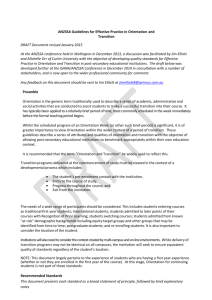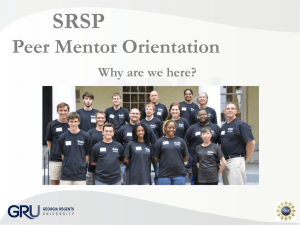click to
advertisement

ANZSSA Guidelines for Effective Practice in Orientation and Transition DRAFT Document revised May 2015 At the ANZSSA conference held in Wellington in December 2013, a discussion was facilitated by Jim Elliott and Michelle Orr of Curtin University with the objective of developing quality standards for Effective Practice in Orientation and Transition in post-secondary educational institutions. The draft below was developed further at the ISANA/ANZSSA Conference in December 2014 in consultation with a number of stakeholders, and is now open to the wider professional community for comment. Any feedback on this document should be sent to Jim Elliott at jimelliott8@iprimus.com.au Preamble Orientation is the generic term traditionally used to describe a series of academic, administrative and social activities that are conducted to assist students to make a successful transition into their course. It has typically been applied to a relatively brief period of time, most commonly scheduled in the week immediately before the formal teaching period begins. Whilst the scheduled program of an Orientation Week (or other such brief period) is significant, it is of greater importance to view Orientation within the wider context of a period of transition. These guidelines describe a series of attributes and qualities of orientation and transition with the objective of allowing post-secondary educational institutions to benchmark appropriately within their own education context. It is recommended that the term “Orientation and Transition” be widely used to reflect this. Transition programs delivered at the commencement of study must be viewed in the context of a developmental process which includes: The student’s pre-enrolment contact with the institution, Entry to the course of study, Progress throughout the course, and Exit from the institution. The needs of a wide range of participants should be considered. This includes students entering courses as traditional first year students; International students; students admitted to later points of their courses with Recognition of Prior Learning; students switching courses; students admitted from known "at-risk" demographic backgrounds including equity target groups and other groups that may be identified from time to time; postgraduate students; and re-enrolling students. It is also important to consider the location of the student. Institutions will also need to consider the context created by multi-campus and on-line environments. While delivery of transition programs may not be identical on all campuses, the institution will seek to ensure equivalent quality of standards regardless of the student's location. NOTE: This document largely pertains to the experience of students who are having a first year experience (whether or not they are enrolled in the first year of the course). At this stage, Orientation for continuing students is not part of these standards. Recommended Standards This document presents each standard as a broad statement of principle, followed by brief explanatory notes Standard One: Institutions should clearly articulate both the longer and shorter term transition objectives of orientation. Articulating the longer term goals of orientation will clearly demonstrate that there is significantly more to orientation than may be achieved in brief pre-teaching period. Institutions will need to consider redelivery of critical information at appropriate points throughout the course of study, with particular emphasis on the first teaching period. The broad longer term goals of transition programs may be expressed as: Student Development: assisting new students to participate comprehensively in the life of the educational institution. This will include access to resources and services that will positively contribute to the student’s intellectual, emotional, social, ethical, physical and spiritual development during the course of their enrolment. Academic Achievement: equipping students to achieve at least satisfactory levels of academic performance, with a clear preference for the highest possible standard. Student Retention and Persistence: encouraging students to remain enrolled and persist through the remainder of their studies with their education provider. The shorter term attributes of orientation and entry year transition programs may be expressed as: Valuing the new student: demonstrating to new students that they are welcomed and valued by the institution in general and their enrolling area in particular. Communicating Self-Efficacy: assisting students to develop a belief that their own efforts significantly affect their chances of future success. Delivering a Meaningful Experience: relevant to the subsequent student experience and the student's future goals. Effective Delivery of Information: sufficient and timely information for the student to begin study in their course, and timely delivery of other information during their first period of study. Making Connections: assisting all new students to become part of the University community. The program should link new students with peers, senior students and staff. In particular, new students should be made aware of who or which area to approach for assistance. Standard Two: Institutions should give due consideration to the pre-orientation and pre-enrolment period and ensure that clear information is available to incoming students in this period Orientation begins prior to enrolment and institutions should prepare and plan for this via reaching out to students via such channels interactive videos, pre-enrolment campus orientations, and suchlike. On a practical level, it is desirable to provide access to student IDs and online resources (library, intranet, course content management system) well before arrival on campus. Standard Three: Institutions should clearly state the attendance and/or participation requirements in orientation It is generally recommended that student attendance or on-line participation should be considered a requirement. That is, students should be advised that orientation is a compulsory component of their course and that there is therefore an expectation that students will have participated in the orientation program. Participation for students should be interactive, not merely receptive. Standard Four: Institutions should provide on-line access to orientation information This is an alternative for students who are unable to attend in person; back-up information to reinforce the information provided during orientation; and available as a matter of course to students with a wholly online enrolment mode. There should be particular attention given to ensure that the quality of on-line orientation materials is of a high standard, most especially for those students who study wholly on-line. Standard Five: There should be a single designated office or department with responsibility for facilitating the overall orientation program and for ensuring institution-wide quality standards. It is strongly recommended that institutions establish a reference group or working group representing different stakeholder areas – with direction from a single designated office or department. Without a clear office or department responsible, quality standards may become fragmented. Where appropriate, a policy or procedure statement should clarify what standards may directed and by whom. At the same time, delivery of a good quality orientation program involves staff across many areas who have a range of other responsibilities. There must be a suitable planning time line and consultative process to accommodate this. It is recognized that in some cases there may not be a single designated office as described above. In such circumstances, various operational areas should work from a single orientation framework that is aligned across the institution. Standard Six: Notwithstanding the previous standards, the roles and responsibilities of other functional areas within the institution should be clear to all staff within those areas. This will include areas such as central administrative services (such as Admissions and Enrolments), the library, Faculty professional staff, teaching areas, International Office, Research and Development, Venues, Security, Support Services and so forth Staff with an identified role in orientation should be made aware of that role well in advance of the orientation period, and be provided with sufficient training and resources to meet the demands of the role. 1 Standard Seven: Institutions must be able to address compliance standards within the National Code of Practice for Registration Authorities and Providers of Education and Training to Overseas Students and the TEQSA Higher Education Standards Framework, and/or other legislated or regulated standards relevant to the jurisdiction applicable to the institution. See https://www.aei.gov.au/Regulatory-Information/Education-Services-for-Overseas-Students-ESOS-LegislativeFramework/National-Code/Documents/National_Code_2007_pdf.pdf The national code Standard 6 states: “Standard 6 – Student support services Outcome of Standard 6 Registered providers support students to adjust to study and life in Australia, to achieve their learning goals and to achieve satisfactory progress towards meeting the learning outcomes of the course. 6.1 The registered provider must assist students to adjust to study and life in Australia, including through the provision of an age and culturally appropriate orientation programme that includes information about: a. student support services available to students in the transition to life and study in a new environment b. legal services c. emergency and health services d. facilities and resources e. complaints and appeals processes, and f. any student visa condition relating to course progress and/or attendance as appropriate.” From time to time, there may be audit requirements to report on this standard (and other standards within the Code). It is manifestly a requirement to meet this orientation standard. For the TEQSA Higher Education Standards Framework, see http://www.comlaw.gov.au/Details/F2013C00169/Html/Text#_Toc330548935 Chapter One, section 6.5 states “The higher education provider identifies and adequately meets the varying learning needs of all its students, including: • the provision of orientation courses and transition support” This standard is expressed less explicitly than the ESOS Code standard, but applies to all students rather than only to International students. Standard Eight: Institutions will address the specific needs of students from backgrounds which may require some additional level of need in transition. This may include programs for students with disabilities and/or medical conditions, equity target groups, students commencing via alternate entry pathways, international students, mature-aged students – or any other groups which may be identified from time to time. Notwithstanding providing targeted support for students from such backgrounds, it is also desirable to provide integrated orientations programs for all incoming students wherever feasible. Standard Nine: Orientation should have the status of including a formal welcome from the most senior member of the institutions Executive, and a culturally appropriate indigenous welcome. A welcome from a Vice-Chancellor (or equivalent status) is indicative of the importance placed on the entry of new students to the institution. 2 A culturally appropriate indigenous welcome will vary between New Zealand and different regions of Australia. However, the quality applied to whatever indigenous welcome is applied should be equal in status to other key events such as graduation ceremonies, major conferences and the like. Standard Ten: Institutions should ensure that certain core content is provided. This will include: Information about student rights and responsibilities (sometimes expressed as a Student Charter) Clear information how to address a complaint or concern Equity All administrative processes The provision of library services Introduction to effective use of IT The provision of support services Standard Eleven: There should be significant involvement of current students in the delivery of orientation. This will include a role for the student Guild, union or other representative organization, as well as opportunities for current students to assist as volunteers and/or mentors The involvement of current students is to the benefit of all participants. Senior students are the best ambassadors and advocates an institution has. They gain leadership experience and a sense of commitment from their involvement in orientation. New students frequently find current students to be a highly approachable source of advice and support. There is also a gain in the sense of community building within the institution. Standard Twelve: Students shall have an opportunity to provide feedback on orientation Student feedback on orientation is critical in order to evaluate its effectiveness, and to assist in planning future programs. This will include measures of student satisfaction, quality, and usefulness. Standard Thirteen: Institutions should have appropriate risk management plans for Orientation This will include safety protocols (particularly with respect to students under the age of 18), and processes to assist students who miss Orientation for whatever reason. Standard Fourteen: Institutions should have appropriate channels whereby all information delivered to students during the Orientation period is easily accessible after that period. It is a common observation that Orientation itself is a period of “information overload” for new students. It is therefore necessary that the information delivered can be easily found. It is also desirable that institutions have systems in place to communicate critical information at timely points in the student life cycle. Standard Fifteen: Orientation and transition information and processes relevant to the individual student’s course of study is of critical importance It is recognized that orientation programs typically occur at three levels. There is frequently a centrally scheduled program of information sessions. These are often optional and not necessarily relevant to all students. Second, there is frequently a social program. Third, there will be a program at course level which should be of high relevance to the students enrolled in that area. Institutions should enable teaching areas to deliver a high quality program at this level. The guidelines below set out expectations with respect to course level orientation. 3 Faculty, School and Departmental Guidelines for Orientation Programs School and departmental orientations may be seen as the most critical component of the whole program given that student engagement at course level is highly significant for persistence and success through to graduation. For many new students, contact with their teaching area will be their first face-to-face experience with staff and with other students. It is important that this contact: 1. Is a positive experience 2. Delivers information that is relevant and useful to the student in the immediate short term – and avoids seeking to deliver too much information 3. Connects new students to key staff and to other students – i.e. that the program begins to build relationships 4. Delivers the key message that students can easily find information, support and advice as needed at later points in their student career. The Guidelines are divided into two sections –content that is seen as essential, and more general recommended guidelines for good practice in the quality of the orientation program. SECTION ONE: Essential content A brief overview of the course – with a focus on what new students need to know now Matters to take into Consideration: Too much detail can be counter-productive Major choices and options within the program Career outcomes Where to find more detailed information at a later point Information regarding the administration of the course Appropriate information about use of the library Student Rights and Responsibilities; and Relevant Safety and Legal Issues Matters to take into Consideration: There may a number of clear standards to communicate that derive from any existing Student Charter or similar document What students can expect from the institution What the institution expects from students Teaching areas can communicate their expectations of student behaviour. Any existing grievance and complaints processes In some areas, it will be relevant to address matters such as: Safety in the laboratory Dealing with hazardous equipment Safety requirements associated with practicum placements Working with Children Clearances Ethical considerations Other particular matter that are specific to the discipline area Highlight the significance of Unit Outlines or similar documents describing courses of study Matters to take into Consideration: Deliver a strong message that all students are expected to be aware of the content of unit outlines Some aspects of Unit Outlines can be addressed in the Orientation period, but it will be necessary to follow up in the teaching weeks 4 This is also a point at which academic integrity and plagiarism issues may be introduced – although it will clearly also be necessary to follow up later in the teaching program Orientation to the Department’s specific facilities Matters to take into Consideration: Resource rooms IT facilities Places for students to meet Relevant academic clubs Support staff Other particular facilities of importance to the teaching area Allow significant time on the schedule for any existing student mentor programs Matters to take into Consideration: There should be a clear explanation what the mentor program is about and how it operates Create time for mentors to interact with new students. This provides an opportunity to build the mentor:mentee relationship and to answer questions that new students may be unwilling to ask of academic staff on an informal basis Schedule a campus tour conducted by the mentor – possibly part-way through the program so that they have time to interact and then bring back any issues/queries to a plenary session Use mentors to demonstrate departmental facilities Mentors may also demonstrate key IT skills to new students in small groups – how to use the student portal, Learning Management System and any other IT platforms of relevance to the teaching area Involvement of senior students If there is no mentor program, it is still valuable to invite senior students to contribute to the program. Senior students can do many of the activities listed above. A summary of available support services in a single presentation There may be multiple support services, and it is unproductive (and potentially confusing) to invite all services to deliver brief information on what is available. It is better to seek a single representative or possibly show a video highlighting all services. Ensuring that this information is delivered to all International students is a part of Curtin’s ESOS compliance – and the information is also of relevance to domestic students. Such input may include information about: Learning support Counselling Health Careers Housing/Accommodation Services Student Advisory services Recreation facilities Student Guild/Union services Parking and transport Campus security Disability support Financial support And any other services The IT Environment New students should be provided with appropriate information about the IT needs associated with their course. As noted above, it can be productive to invite mentors or senior students to work through this 5 with new students in small groups. Matters to take into Consideration: Providing information about availability of computers to students; plus the terms and conditions associated with student use of institutional computers Maximizing new students’ understanding of the student portal Introducing students to the Learning Management System Introducing students to any other course-specific IT resources Activities that build social connections A key goal of orientation is that new students should meet and interact with other new students, current students and the staff that they are likely to be working with. Consider programming activities that increase the chances of this happening. There are many options, including: Morning tea, lunch, BBQ, or other food-orientated socialising Team games The use of interactive technology to encourage student engagement Campus and/or departmental tours by mentors An engaging group assignment to help students network and make friends in their course Utilising any intra and inter-department sporting opportunities via recreation services Connecting new students to volunteering opportunities 6 SECTION TWO: General Recommended Guidelines for Orientation Program Quality Minimizing unhelpful duplication Matters to take into Consideration: If there are sessions at both faculty and school/departmental level, it is important to ensure there is not needless presentation of the same information. At the same time, it is not necessarily poor practice to reinforce particular key messages to new students A welcoming and positive atmosphere Matters to take into Consideration: The choice of venue for departmental sessions matters. Book the best possible venue that is available. Congratulate beginning students on their choice of university and course; and their success in gaining entry. It is useful to accentuate that students’ own actions make a difference to their success The quality of speakers - use people who have some rapport with an audience. Keep the number of speakers to a minimum as students lose interest if there are too many Involve your current students – either your mentors or other senior students if there is no mentor program. See further note on this elsewhere. Outside of formally scheduled sessions – aim for all staff to be as helpful and courteous as possible. One very negative experience for a student can outweigh many positive experiences. Introduction to the staff that new students need to know Matters to take into Consideration: This will most likely include the Head of School, Unit/ Course coordinators, some Lecturers, and relevant administrative staff. Students will need access to the names of these key people after the event as they will very likely forget – a handout, a follow-up electronic message or URL can help. They do not all need to make a speech Do not waste students’ time on introducing people who are not directly relevant to the transition into their course Encourage students to attend the centrally scheduled Orientation activities Matters to take into Consideration: Ensure all students have access to the Orientation program materials; and advise those who o don’t have these materials where they are available from. Especially encourage students to access any introductory programs offered by the library Depending on when departmental Orientation programs occur, it is helpful to encourage students to attend the centrally programmed sessions. Student Guild or other student representative Input It is important to include input from the Student representative (however that may be structured at the institution), particularly at faculty level sessions. Students should be made aware of: The role as their representative and advocate The role as a service provider The opportunities that the representative body provides for students to become involved in extra-curricular activities Opportunities for new students to ask questions New students may feel reluctant to ask questions in large groups. It is worth introducing processes 7 that allow them ask questions in different settings. Options include: Informal questions directed to student mentors whilst on campus tour Schedule a senior student panel – new students will often direct questions to current students Set up a “Post Box for Questions” that students can drop a note into – and schedule a “debrief” session at the end of the program to answer them. Identify the persons and/or offices where students can take queries Date Document Endorsed by ANZSSA Date for Review 8 9





